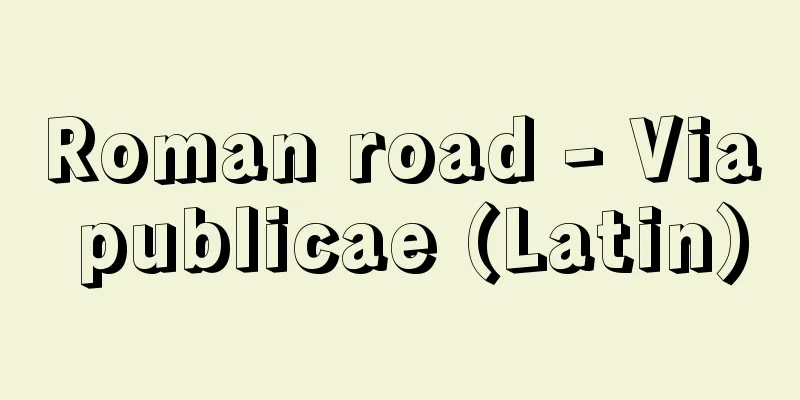Roman road - Via publicae (Latin)

|
Ancient Roman highways. As Rome continued to conquer and rule, it built a network of national highways throughout the empire. The total number known from the time of Emperor Diocletian (reigned 284-305) was 372 roads, totaling 85,000 km. These roads were built in a radial pattern from the capital Rome, transporting people, goods and information to every corner of the empire. [Yuge Tatsuya] History of constructionThe oldest road, whose construction date is unknown, is the Via Latina, which runs southeast from Rome, and the oldest road with a clear construction date is the Via Appia, built in 312 BC, which originally ran from Rome to Capua, but was extended to its southern end, Brundisium, by 244 BC. In 220 BC, the Via Flaminia was built from Rome to Ariminum (now Rimini) on the Adriatic coast. Around 130 BC, the Via Egnatia was built, which crossed Macedonia in northern Greece from east to west, passing through Thessaloniki to Byzantium (now Istanbul). This was to secure the newly merged Kingdom of Pergamum, and as in these examples, all of these roads were built to serve military purposes at the time. However, road construction in the provinces did not begin in earnest until the Imperial period, with roads being built in Dalmatia (present-day Croatia) during the reign of Emperor Tiberius (reigned 14-37), in Gaul during the reign of Emperor Claudius (reigned 41-54), and in North Africa and the eastern provinces during the reign of Emperor Hadrian (reigned 117-138). The construction of national roads came under the jurisdiction of the holder of the Imperium, who had the power to convert private land into state property, the ius publicandi, but the actual work was carried out by the censors, who had the power to build structures on state land, and who contracted the work out to state contractors. Many roads, such as the Appian Way, were named after these censors. However, during the Imperial period, specialized officials called curatores viarum (road supervisors) were appointed to manage and repair the roads under the emperor. However, work in provincial areas was assigned to the cities within the province under the responsibility of the governor. The costs of building, maintaining, and repairing roads were shared between the Roman state treasury, the cities under its control, and the landowners along the roads, who were exempt from taxes and other public charges. During the Imperial period, the emperor often undertook the huge costs of road repairs with his own money. [Yuge Tatsuya] Road structureMilestones called miliarium were placed at regular intervals along the roads, and the names of the builders, such as consuls and emperors, and the officials who built and repaired them were inscribed on them, along with the number of Roman miles from the starting point, milia passus. Road structures varied depending on the era and region, but generally, large stones were buried at the bottom, and pebbles and gravel were laid on top of that, with cement added in some places. The roads themselves were generally made slightly higher than the rest of the land, had gutters on both sides, and ran as straight as possible. In undulating terrain, the roads ran on higher ground to avoid valleys. Rivers were crossed by wooden bridges in the old days, and later by stone bridges, but there are also records of ferries being used, and inscriptions recording the digging of tunnels. [Yuge Tatsuya] Ekiden SystemThese national roads could only function effectively if there was a system of public carriages (cursus publicus) that allowed them to be used. According to this system, horse exchange stations (mutationes) and lodging facilities (mansiones) were set up at certain intervals along each road. Official travelers traveled to their destinations by foot or by carriage, passing through these relay stations. The movement of the army and the transportation of goods necessary for the state were also the work of the public carriages. The provision of horses, personnel, and carriages to these relay stations was requisitioned from the residents along the roads. This was a heavy burden, and together with the requirement that the army stay in nearby houses during the movement of the army, it was sometimes an unbearable burden for the residents along the roads. Nevertheless, although it was only because of this system of public carriages that people could travel safely along the national roads, the use of the public carriages was permitted only to official travelers, that is, those who had a diploma, so in reality, the national roads were not convenient for everyone. Moreover, during the imperial period, the issuance of permits was in the hands of the emperor, who rarely issued them to private travelers. This meant that it was very expensive for merchants to transport heavy and bulky goods such as grains over land, for example. The price of wheat doubled when it was transported 450 km. It also cost the same amount of wheat to ship about 1,875 km from Alexandria to Rome as it did to transport it 75 km by land. Considering these factors, the road network that covered the entire Roman Empire did not benefit the general population, but the development of the road network and public transportation played a major role as the main artery of the huge empire. The speed at which people walked on this road was about 30 km per day according to the standard calculations in court and military marching exercises, but the actual records showed that it was 29, 36, or 48 km. The fastest example of a horse courier was a courier who reported the murder of Emperor Maximinus in the early 4th century, and traveled an average of 225 km per day. Apart from this special case, it seems that a speed of 120 to 150 km per day was possible. The most common way for private individuals to use the national highway was to entrust letters to the courier tabellarius. [Yuge Tatsuya] [Reference] |Construction of an ancient Roman highway started by Claudius Cacues in 312 BC. The stone-paved road still retains traces of its former glory. Rome, Italy ©Shogakukan "> Appian Way Source: Shogakukan Encyclopedia Nipponica About Encyclopedia Nipponica Information | Legend |
|
古代ローマの国道。ローマは征服と支配が進むにつれて全帝国に国道網を張り巡らした。ディオクレティアヌス帝(在位284~305)時代の総数が知られているが、道路本数372本、延長8万5000キロメートルであった。これらの道路は首都ローマから放射状に建設され、帝国の隅々まで人間・物資および情報を伝達した。 [弓削 達] 建設の歴史建設年代は不明だが最古のものと思われるのは、ローマから南東に走るラティーナ街道であり、また建設年代の明らかな最古のものは紀元前312年のアッピア街道で、初めローマからカプアまでであったが、前244年までに南端のブルンディシウムまで延長された。前220年、ローマからアドリア海沿岸のアリミヌム(現リミニ)までフラミニア街道が建設された。また前130年ごろには、ギリシア北部のマケドニアを東西に横断してテサロニケ(テッサロニキ)を経てビザンティオン(現イスタンブール)に至るエグナティア街道が建設された。これは、そのころ合併されたペルガモン王国を確保するためのもので、この例のようにすべてその時々の軍事的目的に奉仕するために建設されたものであった。しかし属州での道路建設が本格的に行われたのは帝政期に入ってからで、ティベリウス帝(在位後14~37)の時代にはダルマティア(現クロアチア)、クラウディウス帝(在位41~54)の時代にはガリア、ハドリアヌス帝(在位117~138)の時代には北アフリカと東部の諸州で、それぞれ相次いで整備された。 国道の建設は、私有地を国有地に転用する権限ius publicandiをもつインペリウム保持者の管轄に属したが、実際の仕事は、国有地に建造物を建設する権限をもつケンソルが担い、それを国家事業請負業者に請け負わせて遂行した。アッピア街道などの街道名につけられた名前は、多くこのケンソルの名であった。しかし帝政期に入ると、道路世話役curatores viarumという専門役人が置かれて、皇帝の下に管理・修復にあたった。ただし属州での仕事は、総督の責任の下に属州内諸都市に割り当てられた。道路の建設・維持・修復の費用は、ローマの国費と統治下諸都市と、税その他の公課を免除されていた道路沿いの土地所有者とによって分担された。帝政期には皇帝が私財で道路修復の巨費を引き受けることもしばしばあった。 [弓削 達] 道路の構造道路上には一定間隔を置いて里程標石miliariumが置かれ、その上に、コンスル・皇帝など建設者と建設・修復にあたった役人の名が刻まれ、また起点からのローマ・マイル数milia passusが明記された。道路の構造は、時代・地方によりさまざまであるが、だいたいは、最下層に大きな石を埋め、その上に小石、そして砂利を敷き、所によってはセメント舗装が加えられた。道路そのものは全体として他の土地よりすこし高くされ、両側に側溝もつけられ、できる限り一直線に走らされた。起伏のある土地では谷あいを避けて小高い土地を走った。川は、古くは木橋で、のちには石橋で渡ったが、渡し船を使っていた記録もあり、トンネルが掘られたことを記した碑文もある。 [弓削 達] 駅伝制度これらの国道は、これを利用する公共便cursus publicusの制度があって初めて有効に機能した。この制度によって、各街道の一定距離ごとに馬車用の馬の交換所mutationesと宿泊施設mansionesが置かれた。公用旅行者は徒歩または馬車で、これら中継所を伝って目的地に向かった。軍隊の移動、国家に必要な物資の輸送も公共便の仕事であった。これら中継所への馬・人員・馬車の提供は沿道住民から徴発された。これは重い負担で、軍隊移動時の近隣民家への分宿とともに、街道沿い住民にはときに耐えられない重圧ともなった。それにしても、この公共便の制度があって初めて国道を安全に旅行できたのであるが、公共便の利用は公用旅行者、すなわち許可証diplomaを受けた人のみに許されたから、国道は実質的にはだれでも便利に使えたというものではなかった。しかも許可証の発給は帝政期には皇帝の手に握られ、皇帝は私用旅行者にはめったに与えなかった。このため、たとえば商人が穀物のような重くてかさ高い物資を陸上輸送するには非常な経費がかかった。小麦は450キロメートル輸送されるとその価格は倍加した。また、同一量の小麦をアレクサンドリアからローマまでの約1875キロメートル舶送する費用と、75キロメートル陸送する費用とが同じであった。こうしたことから考えて、ローマ全帝国に張り巡らされた道路網は、一般住民の利益にはつながらなかったが、巨大な帝国の大動脈として道路網と公共便の整備が果たした役割は大きい。この道路を人が徒歩で行く速度は、法廷での計算や軍隊の行軍演習の標準でみると1日約30キロメートルであり、実際の記録でみると29、36、48キロメートルなどであった。馬を使った早飛脚のもっとも速い例は、4世紀初めマクシミヌス帝殺害を知らせた早飛脚の1日平均225キロメートルであった。この特殊例を除けば1日120ないし150キロメートルの速度は可能であったように思われる。私人の国道利用のもっとも普通のやり方は、飛脚tabellariusに手紙を託すことであった。 [弓削 達] [参照項目] |紀元前312年、クラウディウス・カクエスによって着工された古代ローマの幹線道路。石の舗装路に往時の面影が残る。イタリア ローマ©Shogakukan"> アッピア街道 出典 小学館 日本大百科全書(ニッポニカ)日本大百科全書(ニッポニカ)について 情報 | 凡例 |
<<: Romanist (English spelling) Romanisten [Netherlands]
Recommend
To corner - to corner
〘Other Ma Lower 1〙 Ohitsu-mu 〘Other Ma Lower 2〙① T...
Mehmet Ākif
1873‐1936 Turkish poet. Author of the lyrics for t...
Afghan - Afghan (English spelling)
They are an ethnic group that accounts for 50-60%...
Yunishigawa [Hot Spring] - Yunishigawa
This hot spring is located in Kuriyama Village, Sh...
Kahoon Papyrus - Kahoon Papyrus
…There are several medical papyri that directly s...
Celastrus capillaris - Celastrus capillaris
… The genus Adiantum is common in tropical and wa...
Aluminosilicate minerals - aluminosilicate minerals
A general term for silicate minerals whose basic b...
Remote sensing
Remote sensing is the technique or technology for ...
Kasugasha
...Moreover, Kofuku-ji Temple welcomed imperial e...
Rational form
Also known as a fractional expression. For one-var...
Old age pension - roureinenkin
A pension paid to elderly people over a certain a...
Kawaji [Hot Spring] - Kawaji
This hot spring wells up at the confluence of the ...
Schreiner finishing (English spelling) Schreinerfinishing
…The raised areas are glossy. The process of proc...
Chikugo River
It is the largest river in Kyushu, spanning four ...
Dry salting method
...The blood is squeezed out in the same way as f...









